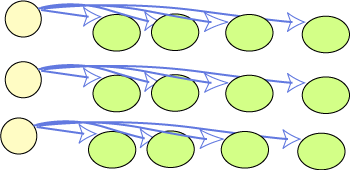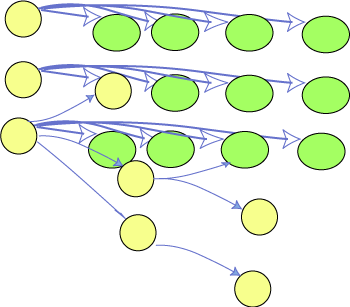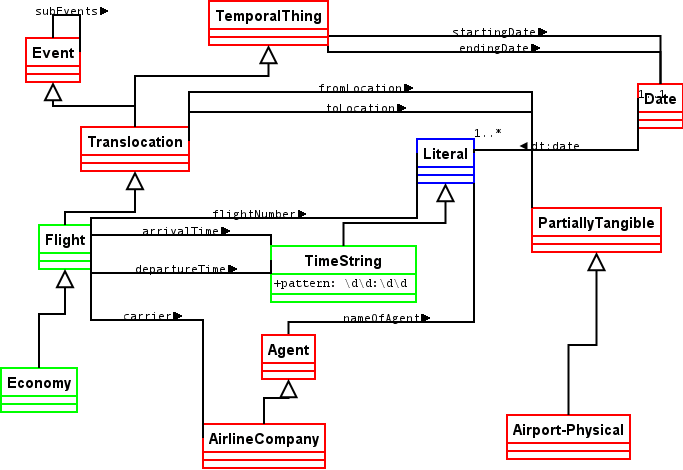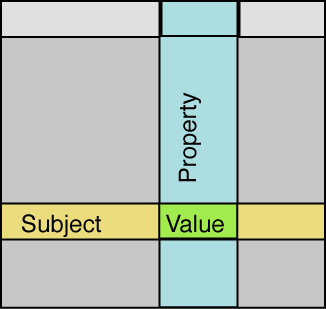Toward proof exchange in the Semantic Web
Dan ConnollyDecentralized Information Group
MIT Computer Science and Artificial Intelligence Laboratory

In this paper, we describe the motivations for, and development of, a rule-based policy management system that can be deployed in the open and distributed milieu of the World Wide Web. We discuss the necessary features of such a system in creating a "Policy Aware" infrastructure for the Web, and argue for the necessity of such infrastructure. We then show how the integration of a Semantic Web rules language (N3) with a theorem prover designed for the Web (Cwm) makes it is possible to use the Hypertext Transport Protocol (HTTP) to provide a scalable mechanism for the exchange of rules and, eventually proofs, for access control on the Web. We also discuss which aspects of the Policy Aware Web are enabled by the current mechanism and describe future research needed to make the widespread deployment of rules and proofs on the Web a reality.
Daniel Weitzner, Jim Hendler, Tim Berners-Lee, and Dan Connolly. Creating a policy-aware web: Discretionary, rule-based access for the world wide web. In Elena Ferrari and Bhavani Thuraisingham, editors, Web and Information Security. IRM Press, 2006.
Current working some PAW examples include:
The troop policy is:
- Photos taken at meetings of the troop can be shared with any current member of the troop.
- Photos taken at a jamboree can be shared with anyone in the troop or with anyone who attended the jamboree.
- Photos of the girls winning awards can be shared with anyone currently in the troop, or who was ever a member. These award photos can also be shared with the public if, and only if, the girl's parents allow it.
For more, see:
The TAMI Project is creating technical, legal, and policy foundations for transparency and accountability in large-scale aggregation and inferencing across heterogeneous information systems. The incorporation of transparency and accountability into decentralized systems such as the Web is critical to help society manage the privacy risks arising from the explosive progress in communications, storage, and search technology. The expansion of government use of large-scale data mining for law enforcement and national security provides a compelling motivation for this work. While other investigations of the impact of data mining on privacy focus on limiting access to data as a means of protecting privacy, a variety of social, political, and technical factors are making it increasingly difficult to limit collection of and access to personal information. The TAMI Project is addressing the risks to privacy protection and the reliability of conclusions drawn from increasing ease of data aggregation from multiple sources by creating methods and technologies for adding increased transparency and accountability of the inferencing and aggregation process itself. The project is developing precise rule languages that are able to express policy constraints and reasoning engines that are able to describe the results they produce.
Adverse actions premised on inferences from data where the data, while factually correct and properly in possession of the user, is used for an impermissible purpose.
TSA finds a possible name match (of a very common name) between a person in a Passenger Name Record and a person in the Terrorist Screening DataBase and properly sends the information to the FBI. The FBI arrests him for unpaid child support under the federal "Deadbeat Dad" statute. This will turn out to be impermissible because:
- the SORN says the purpose of collecting Passenger Name Record information is "to enhance the security of domestic air travel by identifying only those passengers who warrant further scrutiny" and
- the Privacy Act requires USPerson data to be used only for the purposes for which it was collected.
| Web | Semantic Web | |
|---|---|---|
| Traditional Design | hypertext | logic/database |
| + | URIs | |
| - | link consistency | ? |
| = | viral growth | |
Are there parts of traditional logic and databases that, if we set them aside, will result in viral growth of the Semantic Web?

Note the relationship to HTML links, especially with the re-discovery of the rel attribute in microformats: vote-for, friend, etc..



MyConf conf:eventName "WWW2006 Workshop on Models of Trust for the Web". MyConf conf:numOfRegistrants 65.
@forSome X. j:Joe foaf:knows X. X foaf:name "Fred" . j:Joe foaf:knows [ foaf:name "Fred" ] .
This is an N3 subset that corresponds to the RDF/XML standard.
RDF Schema (RDFS) and the Web Ontology Language (OWL) correspond to UML notions such as subclass, domain, range, cardinality, etc.

Aggregate data from friends etc, then...

PREFIX foaf: <http://xmlns.com/foaf/0.1/>
PREFIX c: <http://www.w3.org/2002/12/cal/icaltzd#>
SELECT ?name, ?summary, ?when
FROM <myFriendsBlogsData>
WHERE { ?somebody foaf:name ?name; foaf:mbox ?mbox.
?event c:summary ?summary;
c:dtstart ?ymd;
c:attendee [ c:calAddress ?mbox ]
}.
| ?name | ?summary | ?when |
|---|---|---|
| Tantek Çelik | Web 2.0 | 2005-10-05 |
| Norm Walsh | XML 2005 | 2005-11-13 |
| Dan Connolly | W3C tech plenary | 2006-02-27 |
See SPARQL Query Language for RDF W3C Working Draft 21 July 2005
@keywords is, of, a.
@prefix : <#>.
socrates a Man.
{ ?who a Man } => { ?who a Mortal }.
socrates a Man.
abbreviates
<#socrates> <http://www.w3.org/1999/02/22-rdf-syntax-ns#type> <#Man>.
We can say this much using just the RDF/RDFS standards:
socrates a Man. Man rdfs:subClassOf Mortal.
And then we can implement the standard RDFS semantics with rules:
@prefix rdfs: <http://www.w3.org/2000/01/rdf-schema#> .
{ ?X a [rdfs:subClassOf ?C] } => { ?X a ?C }.
1: ... [by parsing <socrates.n3>]
2: :socrates a :Man .
[by CE on 1]
3: @forAll :who . { :who a :Man . } log:implies {:who a :Mortal . } .
[by CE on 1]
4: ...
[by GMP on 3, [2]]
5: @forAll :who . :socrates a :Man, :Mortal . { :who a :Man . } log:implies {:who a :Mortal . } .
[by CI on [1, 4]]
@prefix foaf: <http://xmlns.com/foaf/0.1/>.
@prefix log: <http://www.w3.org/2000/10/swap/log#> .
@forAll WHO.
{ WHO foaf:homepage ?PG.
?PG log:semantics [ log:includes { WHO a Vegetarian } ]
} => { WHO a Vegetarian}.
@forAll WHO.
{ WHO foaf:homepage ?PG.
?PG log:semantics [ log:includes { WHO a Vegetarian } ]
} => { WHO a Vegetarian}.
<joe_profile.n3#joe> foaf:homepage <joe_profile.n3>.
<#joe> foaf:homepage <>; a Vegetarian.
1: ...
[by parsing <conf_reg_ex.n3>]
2: :joe <http://xmlns.com/foaf/0.1/homepage> <file:/Users/connolly/w3ccvs/WWW/2000/10/swap/test/reason/joe_profile.n3> .
[by CE on 1]
3: <file:/Users/connolly/w3ccvs/WWW/2000/10/swap/test/reason/joe_profile.n3> log:semantics {joe:joe a :Vegetarian; <http://xmlns.com/foaf/0.1/homepage> <file:/Users/connolly/w3ccvs/WWW/2000/10/swap/test/reason/joe_profile.n3> . } .
[by built-in Axiom log:semantics]
4: { joe:joe a :Vegetarian; <http://xmlns.com/foaf/0.1/homepage> <file:/Users/connolly/w3ccvs/WWW/2000/10/swap/test/reason/joe_profile.n3> . } log:includes {joe:joe a :Vegetarian . } .
[by built-in Axiom log:includes]
5: @forAll :WHO, con:PG . { @forSome foo:_g3 . foo:_g3 log:includes {:WHO a :Vegetarian . } . :WHO <http://xmlns.com/foaf/0.1/homepage> con:PG . con:PG log:semantics foo:_g3 . } log:implies {:WHO a :Vegetarian . } .
[by CE on 1]
6: ...
[by GMP on 5, [2, 3, 4, 4]]
7: @forAll :WHO, con:PG . joe:joe a :Vegetarian; <http://xmlns.com/foaf/0.1/homepage> <file:/Users/connolly/w3ccvs/WWW/2000/10/swap/test/reason/joe_profile.n3> . { @forSome foo:_g3 . foo:_g3 log:includes {:WHO a :Vegetarian . } . :WHO <http://xmlns.com/foaf/0.1/homepage> con:PG . con:PG log:semantics foo:_g3 . } log:implies {:WHO a :Vegetarian . } .
[by CI on [1, 6]]